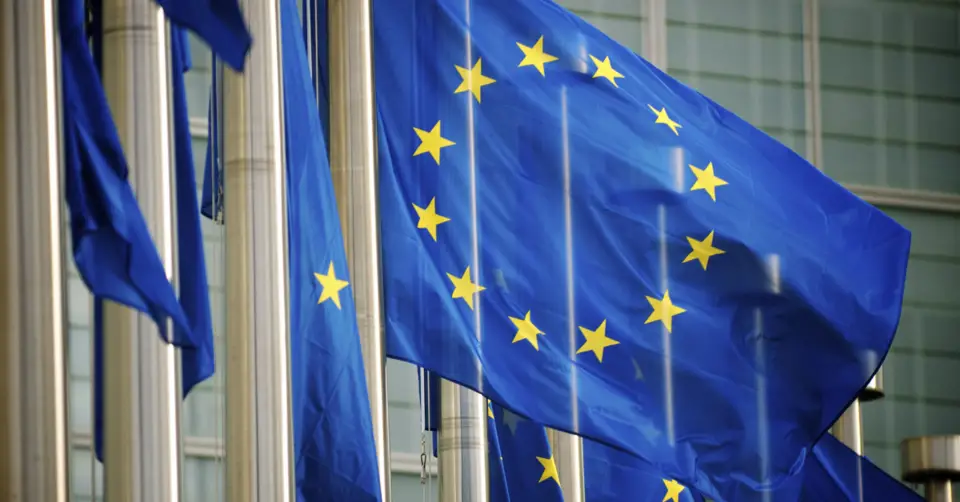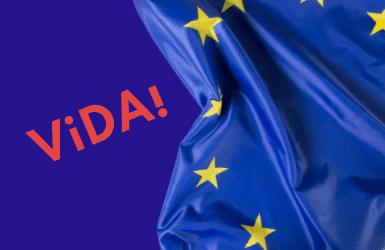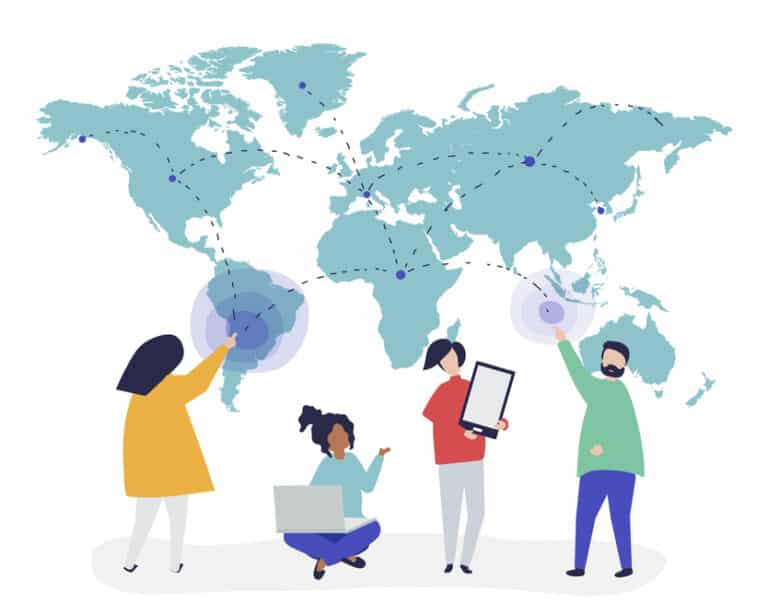Correct implementation of e-invoicing in accordance with the EU directive
Why is there an EU directive for e-invoices?
On April 16, 2014, the European Parliament adopted EU Directive 2014/55/EU 2014/55/EU on electronic invoicing (e-invoicing) for public contracts. The purpose and aim of the directive is to promote the electronic exchange of invoices between companies and public administrations throughout the European Union.
This is made possible by an international standard for e-invoicing. In addition, electronic invoicing is set to become firmly established in the business world in the future, in order to establish a modern, automated invoicing process.
The European standard EN 16931 , which has been in force since 2017, defines very specifically how an electronic invoice must be designed across borders. It forms the basic framework for creating an e-invoice, although country- and industry-specific extensions are also added.
For example, the German E-Invoicing Act includes the E-invoicing regulation (E-Rech-VO)(E-Invoicing Regulation), which defines the settlement of services after the fulfillment of public contracts.
These measures bring advantages not only in the public sector, but also in B2B:
- Gesteigerte Effizienz: Durch automatisierte Prozesse für die Erstellung, Übermittlung, Verarbeitung und Archivierung von Rechnungen. Reduzierung manueller Aufgaben, Fehlerminimierung.
- Kostenersparnis: Der Bedarf an Papier, Druckern, Porto und physischem Speicherplatz wird deutlich reduziert.
- Nachhaltigkeit: Die Reduzierung des Papierverbrauchs und des Transportbedarfs für physische Rechnungen verringert Umweltauswirkungen.
- Förderung des Binnenmarkts: Die Standardisierung von E-Rechnungsformaten und -prozessen macht den grenzüberschreitenden Handel und die Zusammenarbeit zwischen Unternehmen in verschiedenen EU-Mitgliedstaaten sehr viel einfacher.
- Bekämpfung von Betrug und Steuerhinterziehung: Ein wichtiges Argument für E-Rechnungen, denn sie hinterlassen digitale Spuren und können leichter überwacht werden. Dies erschwert betrügerische Aktivitäten.
- Schlanke Verwaltung: Im öffentlichen Bereich reduzieren E-Rechnungen den Verwaltungsaufwand, da die Bearbeitung von Rechnungen automatisiert erfolgt und den bürokratischen Aufwand verringert.
Please find more information on this topic in our article The future of procurement
The following article explains how to implement e-billing in accordance with the EU directive.

Who is required to use e-invoicing?
The German e-invoicing regulation EU Directive 2014/55/EU requires member states to ensure that contracting authorities are able to receive and process e-invoices. Many countries have implemented this directive into national law and issued corresponding regulations for e-invoices in public procurement.
Therefore, companies that do business with the public sector (authorities or institutions such as schools, kindergartens, swimming pools, etc.) must be able to issue, send and receive electronic invoices in accordance with the specifications.
In Germany, for example, XRechnung and ZUGFeRD are the accepted formats for e-invoices in public procurement.
In some countries, however, the obligation to use e-invoices is already coming into effect in business-to-business (B2B). From January 1, 2025, the obligation to use e-invoices will gradually apply to all companies in B2B!
What information must an e-invoice contain?
Creating e-invoices: mandatory information
The EU standard EN 16931 precisely defines what an e-invoice should contain according to the European directive. In addition, there are national adaptations for each country in the EU – as already mentioned, the E-Rechnungsverordnung (e-invoicing regulation) applies here in Germany.
Accordingly, the following mandatory information must be included in an e-invoice:
- Route ID
- Bank details
- Terms of payment
- An e-mail or, if applicable, a De-Mail address for the invoicing party
- Supplier number
- Order number
What is the route ID ("Leitweg-ID")?
The route identification number is used to clearly identify the invoice recipient – it is essential for an electronic invoice to be correctly delivered from the invoice issuer to the recipient.
In addition, the route ID can also be used to forward incoming invoices to the connected administrative units via the central invoice receipt of the federal government ("ZRE – Zentraler Rechnungseingang des Bundes"). Delivery at the state or municipal level also follows this principle. to the associated administrative units will be redirected. According to this principle also the delivery takes place at the country level or the municipalities.
Note: only invoice recipients need a route ID, not the invoicing party. The route ID is communicated to the invoicing party before the invoice is issued.
XRechnung and ZUGFeRD
To be able to issue an e-bill in accordance with EU Directive 2014/55/EU , the invoice data must, above all, be stored in a structured format. The XRechnung format was developed to meet the requirements of the German business environment.
It takes into account both the requirements of the European standard EN 16931 as well as the German law.
XRechnung is based on XML, the Extensible Markup Language. It has proven itself as a standard for the product-neutral exchange of structured data between IT processes. The European Commission currently specifies two e-invoicing syntaxes that must be supported by every public client.
Since both use XML, e-invoices must be converted as XML files to be accepted.
Alternatively, to Format XRechnung may also ZUGFeRD for the application: Abbreviated, Central User Guide of the Forum for Electronic Invoices in Germany , it is also referred to as Facture X at the international level.
ZUGFeRD can be thought of as a kind of hybrid: it combines a PDF file with embedded structured data in XML. This means that a ZUGFeRD invoice is both human-readable, as it looks like a conventional PDF invoice, and contains machine-readable data that can be processed automatically.
ZUGFeRD Community: this platform provides a wealth of up-to-date information and solutions for the ZUGFeRD format. It is worth registering (free of charge).
How do you create an e-invoice in XRechnung format?
Since XRechnung is frequently used in Germany, we have summarized the basic implementation steps for you here:
- Verstehen der Anforderungen: Es macht Sinn, sich als erstes mit den rechtlichen Anforderungen für elektronische Rechnungen auseinanderzusetzen. Dies umfasst vor allem die Anforderungen der E-Rechnungsverordnung (E-Rech-V) – the German e-invoicing regulations – and the XRechnung specifications published by the German government and relevant authorities.
- Auswahl der geeigneten Software: Es gibt inzwischen eine Vielzahl an hilfreichen Programmen, die einen bei der Erstellung von XRechnungen unterstützen, z.B.
Rechnungsprogramme: Diese Option empfiehlt sich, wenn man regelmäßig eine große Anzahl an Rechnungen zu erstellen hat, sicher gehen möchte, dass die Rechnungen rechtskonform sind oder man vielleicht auch gleich ein Mahnwesen mithinzufügen möchte.
Accounting programs: every company needs to do its accounting, obviously! Since this is often a fairly complex matter, many companies nowadays use an accounting program – and most of them also support the creation of XRechnung invoices (e.g. DATEV, Lexwareetc.).
XRechnung generators: Quite simply, these generators allow you to create XRechnung invoices quickly and easily. However, all invoice data must be entered manually, the generated invoice is not human-readable (in case you want to send a copy to your business partner in advance for approval) and there are no storage or archiving functions (there are also retention periods for XRechnung invoices).
So there are various options for creating an XRechnung invoice, and by using the software programs listed, you can be sure that the legal requirements are met and that all the important data is included in the invoice.
- Signieren der Rechnung (optional): Kein Muss, aber wir empfehlen, XRechnungen digital zu signieren, um die Authentizität und Integrität Ihrer Rechnungen zu gewährleisten. Dies kann durch die Verwendung von digitalen Zertifikaten oder elektronischen Signaturen erfolgen.
- Testen der Implementierung: Vor dem Go-Live sollten Sie einen Testlauf durchzuführen, um sicherzugehen, dass alle Anwendungen problemlos funktionieren, die XRechnungen den Anforderungen entsprechen und von den Empfängern akzeptiert werden.
- Kommunikation mit Geschäftspartnern: Öffentliche Auftraggeber sind auf jeden Fall verpflichtet, XRechnungen anzunehmen. Im B2B sollten Sie Ihre Geschäftspartner informieren, dass Sie XRechnungen senden können, und deren Bereitschaft zur Annahme dieses Formats erfragen. Stellen Sie sicher, dass Ihre Geschäftspartner in der Lage sind, XRechnungen zu verarbeiten.
- Versenden von XRechnungen: Wurden alle Tests erfolgreich bestanden und sind Ihre Handelspartner bereit, XRechnungen anzunehmen, steht dem Versand Ihrer XRechnungen nichts mehr im Wege. Dies kann über verschiedene Übertragungswege erfolgen, z.B. klassisches EDI (Electronic Data Interchange) oder eDelivery-Netzwerke wie Peppol.
- Compliance überwachen: Verfolgen Sie weiterhin die Entwicklungen in Bezug auf XRechnung-Standards und -Anforderungen, um sicherzustellen, dass Ihre Implementierung stets den aktuellen gesetzlichen Vorgaben entspricht.
- Prozessoptimierung: Die Umstellung auf elektronische Rechnungsstellung ist immer auch ein guter Anlass, um die Rechnungsprozesse im Betrieb zu optimieren und damit an Effizienz zu gewinnen.
Are you considering switching to electronic invoicing or do you have questions about the technical implementation? As your solution partner, we would be happy to support you in your endeavors!
E-invoicing: important communication protocols
To ensure that an XRechnung invoice is properly received by the recipient, a suitable transmission method is needed. Ultimately, the choice of communication channel also depends on the requirements and preferences of your organization and the technical capabilities of your business partners. We provide a brief overview:
- E-Mail: Eine ziemlich weit verbreitete Methode zur Übertragung von XRechnungen. Die Rechnung wird als Anhang einer E-Mail im PDF- oder anderen unterstützten Format gesendet. Diese Methode ist einfach, aber sie erfordert zusätzliche Maßnahmen zur Sicherung der Daten und zur Erfüllung gesetzlicher Anforderungen.
- FTP (File Transfer Protocol): FTP ist ein älteres, aber immer noch häufig genutztes Protokoll zur Datenübertragung zwischen verschiedenen Computersystemen. Daraus entstanden ist außerdem die Variante SFTP (SSH File Transfer Protocol). This enables data encryption and is therefore considered more secure than classic FTP.
- AS2 (Applicabilty Statement 2): Für einen besonders sicheren Austausch von Geschäftsdokumenten – einschließlich XRechnungen – empfiehlt sich die Nutzung des AS2 protocol is recommended for the particularly secure exchange of business documents, including XRechnung invoices. It offers security features such as data encryption and digital signatures.
- AS4 (Applicability Statement 4): Bei AS4 handelt es sich um die weiterentwickelte Version des AS2 Protokolls – es gilt als eines der sichersten Protokolle und erfüllt auch Anforderungen im High-Secure-Bereich.
In addition, it enables centralized message routing via so-called Message Service Handlers (MSH), thus supporting greater flexibility in message route management.
In contrast to AS2 , the AS4 protocol is significantly more flexible and easier to expand. It supports various message formats, including XML, and allows for easier integration of new message types and standards.
- VANs – Value Added Networks: Dabei handelt es sich um private, geschlossene Netzwerke, die einen sehr sicheren Datenaustausch zwischen Geschäftspartnern gewährleisten. VANs sind häufig Lieferantennetzwerke oder auch Netzwerke wie z.B. Peppol (Pan-European Public Procurement Online). Bei Peppol handelt es sich um ein ist ein europäisches eDelivery-Netzwerk, welches standardisierte Protokolle und Formate für den elektronischen Dokumentenaustausch, einschließlich XRechnungen, bereitstellt. Es wurde mit dem Ziel gegründet, den grenzüberschreitenden Datenaustausch in Europa zu vereinfachen und zu fördern.
Conclusion
In the future, electronic invoicing will continue to play an important role in promoting international trade and simplifying cross-border invoicing. XRechnung has been introduced in Germany, but other European countries are also developing and adopting similar standards to harmonize electronic invoicing.
While XRechnung is currently used primarily in the public sector, private companies could also increasingly switch to this format – especially in view of the upcoming e-invoicing requirement in B2B from January 1, 2025.
Furthermore, since e-invoicing effectively helps to counter fraud and tax crimes, it can be assumed that regulatory requirements will become even stricter and new technologies will be used to address cybersecurity.
To ensure the security and authenticity of e-invoices, blockchain technologies and smart contracts , for example, could be integrated into the invoicing process. This would make it more difficult to manipulate invoices and make the process even more transparent.
Reason enough, then, to take a closer look at the topic of e-invoicing.
FAQ
- What is the purpose of the EU e-invoicing directive?
The aim of EU Directive 2014/55/EU is to promote and simplify the electronic exchange of invoices between companies and public administrations in the EU.
- Who is required to use e-invoicing?
Public authorities in EU member states must already be able to accept and process electronic invoices in accordance with the EU directive.
Companies that work for the public sector as suppliers must issue their invoices in accordance with the EU standard EN 16931 and the specific national requirements.
Seit 1. Januar 2025 gilt die E-Rechnung nach europäischer Richtlinie auch im B2B als verpflichtend: Unternehmen müssen E-Rechnungen empfangen und verarbeiten können.
- Is a PDF invoice valid?
A classic PDF is not considered an e-invoice in the sense of the EU Directive 2014/55/EU! The PDF format cannot fulfill important criteria of an EU-compliant e-invoice, such as the mapping of data in a structured data format.
Die genauen Anforderungen dazu sind in der EU-Norm EN 16931 beschrieben, so wie in den jeweiligen ergänzenden Gesetzesvorgaben der EU-Staaten.
The ZUGFeRD format is a special case: it looks like a PDF, but it also contains all relevant data in a structured way in XML and can therefore be processed automatically.
- What information must an e-invoice contain?
In accordance with the E-Rechnungsverordnung (German e-invoicing regulation), an e-invoice must contain at least the following information:
Route ID
Bank details
Terms of payment
An e-mail or, if applicable, a De-Mail address for the invoicing party
Supplier number
Order number
- Who needs a route ID?
Invoice recipients need a route ID to clearly identify themselves and to ensure that invoices are addressed to them correctly.
Invoice issuers do not need their own route ID.
- Where can I get a route ID?
Invoice issuers receive the route ID from their client.
Invoice recipients from a public authority apply for the routing ID from their federal state or from the Zentralen Finanzwesen des Bundes (ZFB) – Central Financial Authority of the Federal Government – if the recipient is directly subordinate to the federal government.






